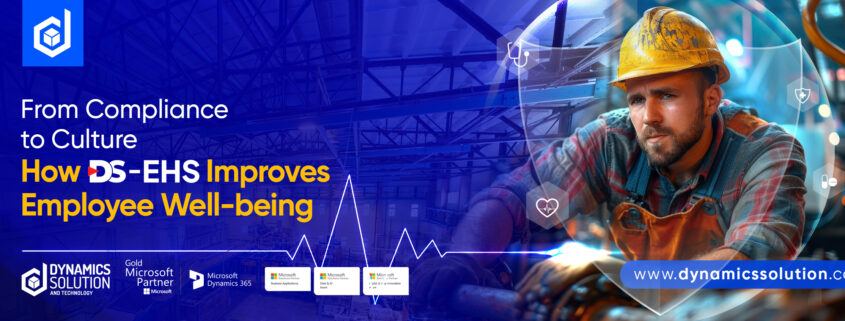In every workplace, there are silent battles being fought. Employees navigate a daily current of stress, uncertainties, and often, health risks. They push through the discomfort of an ergonomic chair or the suffocating atmosphere of a poorly ventilated office. Many know they are exposed to hazards, but they may feel powerless to change their circumstances. DS EHS – Employee Health and Safety aims to change that narrative by focusing on creating a culture of well-being.
According to recent studies, work-related illnesses and injuries lead to billions in lost productivity and employee turnover annually. In this environment of vulnerability, how can we shift from mere compliance to creating a culture of well-being? Let’s explore it in this blog.
How Health and Safety Challenges Manifest in Various Ways:
Before we can embrace a cultural shift, it’s essential to understand the various challenges that employees face regarding health and safety in the workplace. Across industries, employees suffer from work-related illnesses and injuries which can result in:
- Health Risks
The leadership may enforce health and safety regulations, but employees often face exposure to harmful substances, physical strain, and mental stress. A factory worker lifting heavy loads regularly may develop chronic pain, while an office worker may strain their eyes from excessive screen time.
- Lower Employee Morale
Employees are often disengaged from their work. They may feel that safety initiatives are merely box-ticking exercises rather than genuine commitments to their well-being. This disenchantment can seep into every aspect of workplace culture.
- Regulatory Compliance Pressure
Organizations must also navigate complex and ever-changing safety regulations. They worry about fines, but sometimes compliance does not equal safety.
- High Turnover Rates
Unsustainable working conditions contribute to high turnover rates, which further affect teamwork and productivity. Replacing experienced staff is costly and can disrupt the workflow of an organization.
If these struggles consume the workplace, then how can organizations transition from mere compliance to cultivating a culture centered on employee well-being?
Improve Employee Well-being with DS EHS- Employee Health and Safety
Recognizing the challenges is the first step; DS EHS – Employee Health and Safety is the solution designed not just to comply but to elevate workplace health and safety standards. It focuses solely on the workplace and employee well-being, creating safe, healthy, and sustainable environments where people thrive. This proactive solution achieves this by providing:
- Proactive Hazard Identification
DS EHS employs smart systems that systematically identify potential hazards, allowing companies to take preventative action before accidents occur. Imagine a health and safety monitoring app that alerts managers about risks before they escalate into incidents.
- Streamlined Incident Reporting
The platform makes reporting incidents and investigations simple and quick. By enabling seamless digital documentation, it encourages transparency and swift corrective measures.
- Employee Engagement
It fosters a community where employees can voice their safety concerns. By creating channels for interactive forums, employees can engage in safety discussions and share feedback, enhancing collective ownership of safety initiatives.
- Health & Wellness Programs
Beyond safety compliance, it promotes employee health through wellness programs that offer health assessments and ergonomic guidance. This investment in holistic health positively impacts overall productivity and morale.
- Improved Compliance Tracking
Forget about the overwhelming fear of missing compliance deadlines. DS EHS simplifies keeping track of regulations, allowing organizations to focus on their employees’ well-being. This streamlined approach reduces stress and fosters a culture where safety becomes second nature.
A Shift in Culture with DS EHS
Now that we understand how DS EHS can improve workplace conditions, it’s crucial to recognize that implementing it is more than a technical shift; it’s a cultural revolution. The approach places value on employee well-being at the heart of organizational philosophy:
From Compliance to Culture of Safety
In the past, safety often felt like a chore, a set of rules etched in a manual gathering dust on a shelf. With this module, safety transforms into a living culture where employees actively participate.
For instance, we see the shift in a bustling manufacturing plant where safety was once of little concern. After the introduction of DS EHS, safety representatives can conduct regular inspections and engage teams in safety meetings. Employees become part of the safety solution rather than passive recipients of instructions.
Employee Trust and Engagement
An interesting aspect of it is its ability to foster trust among employees. When workers see their organization committed to their safety and well-being, their morale and engagement improve drastically. They feel valued and heard, ultimately enhancing overall job satisfaction.
A software engineer may have felt invisible before. Now, with weekly health workshops and ergonomic assessments promoted by DS EHS, they perceive their workplace as one that truly cares about their health and safety, leading to greater job satisfaction and reduced turnover.
The Optimization Journey of DS EHS
As we embrace this cultural shift, it’s important to also optimize the effects of DS EHS with several strategies, such as
- Ongoing Training
Implement comprehensive, tailored training programs that evolve can with the organization’s needs. Providing specialized training based on specific roles or departments ensures that potential risks are adequately addressed.
- Data-Driven Decisions
The insights gleaned from data collected through DS EHS can provide managers with a roadmap for continuous improvement. By focusing on data-driven decision-making, organizations can track safety trends, mitigating risks proactively and effectively.
- Create a Feedback Loop
Introducing systems where employees can share their experiences with health and safety measures can be invaluable. This feedback fosters transparency and strengthens the safety culture.
- Celebrate Success
Celebrate safety milestones within the organization. Highlighting improvements or achieving zero accidents for a period can galvanize employee morale and increase participation in safety initiatives.
- Community Involvement
Extending your safety initiatives beyond the workplace builds a positive brand reputation. Engaging in community safety programs allows organizations to further underscore their commitment to overall health and safety.
Embracing a Culture of Health and Safety with DS EHS
Transitioning from compliance to culture is a journey. It requires an ongoing commitment from leadership and active participation from all employees. By adopting the DS EHS – Employee Health and Safety model, organizations not only protect their people but foster an atmosphere of trust, engagement, and productivity.
In a world where workplace hazards and stress threaten employee well-being, DS EHS – Employee Health and Safety offers a much-needed lifeline. By shifting from compliance to a culture of well-being, organizations position themselves as leaders in employee empowerment and safety.
The journey begins today. Are you ready to take the first step towards transforming your workplace into a thriving ecosystem where safety is not just a requirement, but a fundamental part of culture? Embrace the DS EHS solution based on Dynamics 365 with Dynamics Solution and Technology and watch as your workforce flourishes, united by well-being and safety, on the path toward a brighter future.







